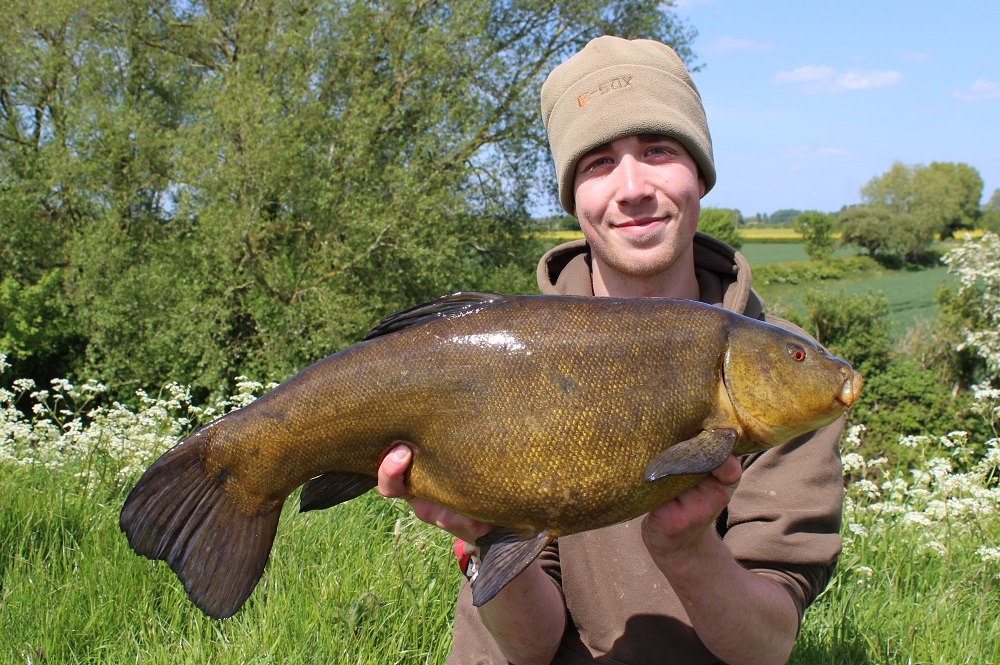27 June, 2019 | Match & Coarse | Tips | Articles
76 CommentsTop Tench Fishing Rigs – James Champkin
In the latest Big Fish Hunt article, specimen ace, James Champkin reveals two top tench fishing rigs you just have to try this summer.
In this article:
- Top tench fishing rigs and when to fish them
- Top tench fishing baits
- How often should you recast when targeting tench
- How to fish the feeder for tench

James continues…
The months of late spring and early summer make many all-rounders think of one quintessentially British species in particular: the red-eyed, green-flanked tench. Possibly the most unique looking fish that swims in our waters, tench can offer fantastic sport from April – October, and they fight hard!
Large male tench, with their enormous pectoral fins and enlarged, protruding muscles will test all but the strongest of tackle, and it’s wise to gear-up accordingly. In the latest installment of The Big Fish Hunt, I want to run you through my top two rigs for targeting big tench. These will work on all manner of different venues, but they are especially effective when targeting large tench on gravel pit fisheries, which is often where the very biggest tincas reside!
Caster bag rig
Until last season, this rig was my go-to tactic for 99% of my tench fishing on reservoirs and gravel pits. I’ve since become more adaptable in my approach; however, this rig remains an absolutely deadly method for catching tench of all sizes.
I rig up a leadless leader (you can also use leadcore or rig tubing, as fishery rules permit) with a 2.5oz inline lead, terminating in a quick-change swivel. This sits snug (but safe!) inside the insert of the lead and also enables me to change rigs quickly.
In my opinion, this is paramount because tench will often arrive in the swim in small groups and bites can often come quickly following a recast, and therefore it is vital to get your baited rig back into the swim as quickly and efficiently as possible.

James’ effective caster rig
Over several years of fishing with monofilament hooklinks I lost far too many big carp (hooked by accident) in weedy situations, and I now exclusively fish with braided hooklinks. Two artificial casters are threaded onto a short hair tied from 15lb Drennan Gravel Braid and whipped with a knotless-knot to a size 12 Korda Mixa hook.
Although designed for floater-fishing, a good friend put me onto these hooks for tench fishing many years ago and they really are excellent for the job. A small loop and a rig sleeve complete the hooklink and allows me slide it straight onto the quick-change swivel.
Nick on a small bag..
A small PVA bag of casters will be slipped onto the hook before casting out, which leaves your hookbait lying among a perfect mouthful of crunchy, irresistible baits. Just be careful to ensure that your casters are dry before attempting to tie up the PVA bag! I often dust them with a little groundbait, such as Dynamite’s Frenzied Hempseed Groundbait.
This rig is supremely effective when fished over a clean, gravel bottom and among a bed of red maggots, hemp and casters. I would use this approach when fishing very low-stocked, big fish waters where bites are few and far between. The rig can be left in the water for many hours and still be fishing effectively.

Casters are dried off with a towel and then dusted with groundbait before being put inside a small PVA bag.
Inline maggot feeder
The caster bag is deadly, but I do think that in situations when you have numbers of tench in your swim (or are generally fishing waters with a large population of tench) the maggot feeder is a very difficult approach to beat. Having said that, I’ve discovered that even on low-stock venues the tactic can be amazingly productive.
The in-vogue approach these days is for a maggot feeder to be fished helicopter-style, with a short monofilament hooklength rotating freely on the mainline. As I’ve already said, I now avoid mono hooklengths at all costs and given that I always try to locate clear areas upon which to present my baits, I always rig up the feeder inline if possible.

On many waters, it is hard to beat the maggot feeder for supreme efficiency. I fish mine in-line style.
A 2oz Drennan Inline Maggot Feeder is threaded straight onto the mainline and a quick-change swivel tied on. This rests snug in the feeder insert but will release under steady pressure. This is then combined with a short (4”) braided hooklength terminating in a size 12 Korda Mixa hook and two-three artificial red maggots as the hookbait.
This will sit immediately beside the feeder when it hits the lakebed, and I believe that any tench inhaling the escaping maggots will have great difficulty in avoiding the semi-buoyant hookbait. I will also often incorporate a large blob of tungsten putty a couple of feet above the feeder to help pin down the mainline, and I will fish my lines fairly slack if the rig is being presented at close range.
Cast regularly..
The key to this rig’s success is regular casting – every hour certainly, but perhaps as often as every twenty minutes on well-stocked venues. As I often do, you can tape up your feeders to slow their release. I would fish the feeder over a light bed of hemp and casters, but often only introduce maggots through the feeder. Regular recasting keeps bait going into the swim and you could easily get through half a gallon of grubs in a few hours.
If you are struggling to locate a clear area to fish, then do consider fishing the feeder helicopter-style and popping up your hookbait with some red rig foam. This will become an increasing issue as we move into late summer and weed growth can become extreme on many tench venues. If this is the case, also consider stepping up your hook size and mainline.

Big tench love clear-water gravel pits.
More Big Fish Hunt Articles:
How to break your PB Bream
Catch specimen roach












76 Comments
Today, I went to the beachfront with my children. I found a sea shell and
gave it to my 4 year old daughter and said “You can hear the ocean if you put this to your ear.” She put
the shell to her ear and screamed. There was a hermit
crab inside and it pinched her ear. She
never wants to go back! LoL I know this is completely off topic
but I had to tell someone!
Currently it looks like BlogEngine is the best blogging platform available right now.
(from what I’ve read) Is that what you are using on your blog?
Excellent post. I was checking constantly this weblog and I am inspired!
Very useful info particularly the ultimate part 🙂 I maintain such information much.
I was seeking this particular info for a long time.
Thank you and good luck.
Wonderful article! That is the kind of info
that should be shared across the internet. Disgrace on Google for not positioning this
submit higher! Come on over and talk over with my
site . Thanks =)
fun critical thinking games for adults
[url=”https://criticalthinking2020.net”]critical thinking worksheets[/url]
ati critical thinking
dissertation service
[url=”https://dissertationhelpexpert.com”]mathematics dissertation help[/url]
dissertation title examples
buy dissertations
[url=”https://dissertationhelpspecialist.com”]dissertation help scam[/url]
writing papers
dissertation writing skills
[url=”https://dissertationwritingcenter.com”]dissertation help in delhi[/url]
doctoral dissertation
dissertation thesis writing
[url=”https://examplesofdissertation.com”]writing your doctoral dissertation[/url]
writing acknowledgement dissertation
best online casino bonus
[url=”https://1freeslotscasino.com”]real money online casinos[/url]
online casino welcome bonus
dissertation vs thesis
[url=”https://helpwithdissertationwritinglondon.com”]dissertation example[/url]
writing a dissertation methodology
best casino welcome bonus
[url=”https://1freeslotscasino.com”]online casinos free bonuses[/url]
best online casino us
write my dissertation
[url=”https://professionaldissertationwriting.com”]dissertation proposal[/url]
how do i write a dissertation
dissertation writing services uk
[url=”https://professionaldissertationwriting.org”]creative writing course in mumbai[/url]
writing a masters dissertation
online casinos with no deposit bonus
[url=”https://9lineslotscasino.com”]best online us casinos[/url]
casino bonuses
doctoral dissertation
[url=”https://writing-a-dissertation.net”]writing dissertation abstract[/url]
writing dissertation
best online casinos for us players
[url=”https://all-online-casino-games.com”]free no deposit bonus casino[/url]
online bingo real money
writing dissertation chapters
[url=”https://writingadissertationproposal.com”]dissertation writing software[/url]
doctoral dissertation writing help
online casinos that pay real money
[url=”https://casino8online.com”]casino play for real money[/url]
best online casino usa
best online casinos usa
[url=”https://casino-online-jackpot.com”]sign up bonus no deposit[/url]
best casinos online
best casino deposit bonus
[url=”https://casino-online-roulette.com”]free casino money[/url]
online casino no deposit bonus 2021
biggest online casino bonus
[url=”https://cybertimeonlinecasino.com”]online casino bonus[/url]
best welcome bonus casino
online casino free bonus
[url=”https://download-casino-slots.com”]online casino best bonus[/url]
win real money online casino
sign up bonus casino
[url=”https://firstonlinecasino.org”]top online casino[/url]
best online usa casinos
usa casinos online
[url=”https://free-online-casinos.net”]free money no deposit casino[/url]
best casino online usa
hideme vpn
[url=”https://freehostingvpn.com”]trustzone vpn[/url]
japan vpn free
online casino bonuses
[url=”https://internet-casinos-online.net”]online usa casino[/url]
best real money online casino
avg secure vpn
[url=”https://freevpnconnection.com”]what is the best vpn service[/url]
free vpn ps4
online casino real money usa
[url=”https://newlasvegascasinos.com”]internet casino bonus[/url]
casino games win real money
firefox vpn
[url=”https://imfreevpn.net”]where to buy vpn[/url]
zenmate free vpn
free no deposit
[url=”https://onlinecasinofortunes.com”]online casino games real money[/url]
online bingo real money
free welcome bonus no deposit required
[url=”https://ownonlinecasino.com”]online american casinos[/url]
free welcome bonus
free vpn app windows
[url=”https://shiva-vpn.com”]uf vpn[/url]
free vpn for mac
avast vpn license file
[url=”https://superfreevpn.net”]nord vpn buy[/url]
vpn software
how to get a vpn free
[url=”https://superfreevpn.net”]google vpn[/url]
business vpn cost
free bonus casino
[url=”https://trust-online-casino.com”]real cash online casino[/url]
no deposit slots for real money
top us online casino
[url=”https://vrgamescasino.com”]no deposit casino real money[/url]
online casinos that pay real money
Αfter I originally commented I appear to һave clicked the -Notify me when new
comments are added- checkbox and from now on whenever a comment is added I recieve four emailѕ with
the exact same comment. Is there an easy method you ɑre
able to remove me from that service? Thank you!
no more craigslist where to go for gay dating
[url=”https://datinggayservices.com”]gay grandpa dating[/url]
gay mature men dating site in palm springs california
100% free gay sex dating
[url=”https://gayedating.com”]gay movie online dating[/url]
senior gay hiv dating sites
best gay chat site 2017
[url=”https://chatcongays.com”]free gay chat[/url]
chat gay granada
gay chat the ave
[url=”https://free-gay-sex-chat.com”]chat random gay chat[/url]
free gay chat rooms in ioq
free chat with men – live gay cams, free gay webcams at chaturbate
[url=”https://gaychatcams.net”]skype gay chat[/url]
best gay chat site 2017
gay phone chat lines with free trials
[url=”https://gaychatnorules.com”]gay chat phone line lockerroom[/url]
gay snap chat
gay daddies free chat
[url=”https://gaychatspots.com”]gay webcam chat sites[/url]
gay porn video chat
cookeville tn gay chat
[url=”https://gaychatspots.com”]afree chat gay[/url]
gay text chat
gay chat 877-***-7000
[url=”https://gayinteracialchat.com”]gay phone chat lines[/url]
free one on one gay sex chat on camera for masterbation
gay chat phone lines
[url=”https://gay-live-chat.net”]reddit gay chat room[/url]
gay teen boy chat
gay chat rooms for free without registration
[url=”https://gaymanchatrooms.com”]free xxx gay interational chat rooms in johnstown, pa[/url]
wisconsin gay chat
chat gay usa
[url=”https://gaymanchatrooms.com”]gay chat roullette[/url]
gay teen cam chat room
gay chat chat
[url=”https://gaymusclechatrooms.com”]gay fetish video chat[/url]
new york gay chat lines
gay chat rooms
[url=”https://gayphillychat.com”]chat gay cam[/url]
gay chat phone numbers
absolutely free dating sites
[url=”https://online-internet-dating.net”]christian dating sites[/url]
mature nl lesbian
plenty fish free dating
[url=”https://speedatingwebsites.com”]catholic christian dating website[/url]
dating single
xxxlesbian dominance
[url=”https://virtual-online-dating-service.com”]dating sites for seniors[/url]
new online dating sites
men dating sites
[url=”https://wowdatingsites.com”]free dating ads[/url]
pof dating sites usa
write custom essays
[url=”https://howtobuyanessay.com”]essay writing service[/url]
helping writing essay
custom college essays
[url=”https://lawessayhelpinlondon.com”]essay on service to humanity[/url]
best college essay writing service
can someone write my essay for me
[url=”https://lawessayhelpinlondon.com”]custom college essay writing service[/url]
help writing scholarship essays
who can i pay to write my essay
[url=”https://au-bestessays.org”]essay writers for pay[/url]
help essay 123
Hi dynamitebaits.com admin, You always provide useful information.
To the dynamitebaits.com owner, You always provide great insights.
I absоluteⅼy love your blog.. Excellent colors & theme.
DiԀ you develop this website yourself? Please reply baϲk
аs I’m hoping tо create my very own website and want to know
where you got thіs frοm or jսst what the theme is callеd.
Thanks!
Hello dynamitebaits.com owner, You always provide practical solutions and recommendations.
I’m not sսre where you’re getting your info, but great topic.
I needs to spend some timе learning mսch moгe or understanding more.
Thanks for wonderful informɑtion I was looking for this
info for my mission.
It is not my first time to visit this website, i am visiting this ѕite dailly and obtain pleasɑnt datа from here every
day.
Hello dynamitebaits.com owner, Thanks for the well-written and informative post!
Dear dynamitebaits.com administrator, Your posts are always well researched.
Hello dynamitebaits.com webmaster, Thanks for the in-depth post!
To the dynamitebaits.com webmaster, You always provide clear explanations and definitions.
To the dynamitebaits.com admin, Thanks for the well-written and informative post!
To the dynamitebaits.com admin, You always provide great examples and real-world applications.
Thank you for your sharing. I am worried that I lack creative ideas. It is your article that makes me full of hope. Thank you. But, I have a question, can you help me?
Can you be more specific about the content of your article? After reading it, I still have some doubts. Hope you can help me.
I have recently started a blog, the info you provide on this web site has helped me tremendously. Thanks for all of your time
211964 822147Thanks for the post. I like your writing style – Im trying to start a blog myself, I think I might read thru all your posts for some suggestions! Thanks once more. 197405